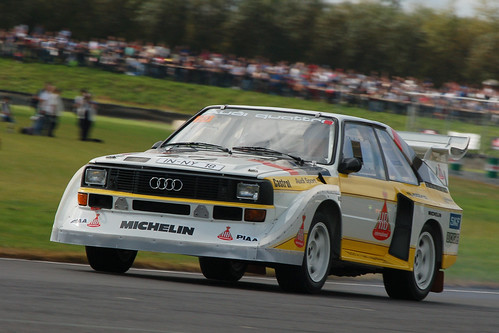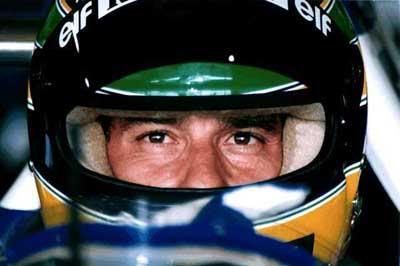
The mighty Audi Quattro S1 (Image: flickr.com)
What can I say? We’ve now moved on to a post I’ve been looking forward to writing. All about quite simply the greatest, if not very short, era of rallying to ever occur. A class of race car so unrestricted and outrageous, it brought thousands of spectators lining the stages. Power levels were astronomical, the crowds were ridiculously huge and the drivers some of the finest ever lived. Its popularity and success brought about its demise after spectator and driver deaths forced the FIA to ban it. This is a collection of cars that became too fast to race. This…is Group B.
The story begins, believe it or not, in 1980, when Audi decided to embark on a project to go rallying. They came up with the unique Quattro, which was so because it was the first competition rally car with four-wheel-drive. The FIA were sceptical at first, as the drivetrain wasn’t allowed in the rules and it was also considered too bulky and heavy to be successful. Taking this into the final verdict, they went ahead and allowed the Quattro to compete, thinking that their 4WD system would just slow it down and make it uncompetitive. How very, VERY wrong they were. A Quattro driven by Hannu Mikkola was used as a course car on an event. It’s a fact that had he been entered as a participant, he would have won by 9 minutes.
The car won it’s first actual event, the Austrian round of the European championship and from there just set the rallying world alight. In 1982, French female driver Michele Mouton became the first woman to win an international motorsports event and so narrowly missed out on becoming World Rally Champion had it not been for the Audi’s transmission failing in the final stages of the Ivory Coast Rally, allowing Opel’s Walter Rohrl to sweep in and claim it. In the same year, Group B was announced. The rules stated that only 200 examples of the car being entered had to be produced before it could be homolgated. It was also a much more relaxed class, with a kind of “anything goes” approach allowing manufacturers to pretty much do what they liked. A further 20 could be produced to allow “Evolution” models, which really were extreme versions of the original car.
Lancia were the first to build a true Group B car with the 037, a modified version of the Beta Monte Carlo. It was rear wheel drive and initially carried 265hp before being boosted to 325 in the Evo model. It won the manufactuers championship for Lancia but Audi’s Hannu Mikkola took the marque’s first Group B driver’s title. Also entering that year had been the little Renault 5 Turbo with a punchy little turbocharged engine mounted in the middle of the car giving it perfect weight distribution and almost go-kart like handling. It won 3 WRC events in it’s lifetime, the Monte Carlo once and the Tour de Corse twice.
By 1984, other manufacturers and people were seriously taking notice. One of those was a certain Jean Todt, who decided to give up co-driving to run a team. He chose to join Peugeot and, after studying the rulebook from cover to cover, came up with a machine based around the little 205 hatchback. The end result – the 205 T16. Again, the engine was mid-mounted and turbocharged but 4WD was adopted. It was smaller and lighter than the big, bulky Quattro and instantly made a huge impact. An accident was the only thing that stopped it taking its first win that year, but Audi could already see them as a serious threat, despite Stig Blomqvist winning the championship for them. In fact, they were so concerned, they were sending messages back to the factory in Stuttgart saying “Don’t stop the development programs just because we’re winning”.
For 1985, Audi and Peugeot made revisions to their cars. The Germans came up with a shorter wheelbase for the Quattro, but it wasn’t really enough to match the Evo version of the 205, with added wings and a secret in the form of an F1-type turbo fitted to the engine. To Audi, the writing really was appearing on the wall for them – big and written in French. Timo Salonen in a way inherited the championship for Peugeot after their star driver Ari Vatanen suffered 3 horrific accidents in a row, the 3rd putting him out of action for the rest of the season. Audi had some serious thinking to do.
All the while, Lancia had still been running the now outdated 037, so a change was needed. They decided to build a new car around the Delta hatchback and came up with the Delta “S4”. It was 4WD, but it’s engine featured something which was sure to put the fear in its rivals – both a turbocharger AND and a supercharger. The reason behind this was to provide as smooth and as constant a power curve as possible. It scored a 1-2 on it’s debut, the 1985 RAC Rally. But they weren’t the only new kids on the block on that event. Ford made a return with the RS200, built by Reliant Engineering, and the MG Metro 6R4, made with help from Williams Grand Prix Engineering. The Ford was a turbo while the Metro was only a naturally aspirated V6. The theory was that with more torque than the turbos, it would help them gain an advantage. Sadly, it didn’t, despite the 3rd place on the RAC in ‘85.
With 1986 shaping up to be a titanic battle for the championship, with Renault also updating it’s R5 Turbo to Maxi form, things were looking promising. Audi made one last update to the Quattro to compete with the competition, with big wings and engine power upped to over 600hp. Everything didn’t run quite as smoothly as people had hoped, though. The increasing popularity of the WRC meant events were attracting ridiculous amounts of spectators, and at times they seemed to form human walls which didn’t leave the drivers room for error. Then, the inevitable happened. A Ford RS200 plunged into a crowd of spectators on the Rally Portugal and killed some 20 people. The event was abandoned after a meeting with the drivers. Things really were getting out of hand. And then came the final nail in the coffin.
On the Rally Corsica, Finnish driver Henri Toivonen and co-driver Sergio Cresto slid off a stage in their Lancia Delta S4, plunged down the mountain side and burst into flames, killing them instantly. Ford and Audi immediately withdrew from the championship, leaving Lancia and Peugeot to fight it out. But it was simply too late. The FIA had been paying too much attention to F1 and as a result, things had gone too far. They had no choice but to ban Group B at the end of ‘86. A sad but sensible decision in order to prevent any more tragedies.
Group B cars weren’t killed off completely just because the category was banned from the WRC. They were adapted and kept on for events such as the Pikes Peak Hill Climb, Paris-Dakar Rally, rallycross and the Race of Champions. In fact, like all race cars, they still exist and are used on historic events and at shows. Who could want to forget awesome cars like these? They truly were monsters with astronomical power figures and mad aerodynamics and shapes.
Henri Toivonen drove his S4 around the Estoril circuit, and the lap time would have been quick enough to put him 6th on the grid for the actual F1 race! Nigel Mansell also tried out a 205 T16 and said that it could out accelerate his F1 car. This was how brutal and crazy these cars were. A Delta S4 was proven to go from 0-60 in just 2.3 seconds on gravel! They were aptly named the “Formula 1 cars of the dirt roads”. A few manufacturers also tried out Group B efforts. Porsche ran their 911 SC against the competition for a couple of years. Toyota created an Group B MR2, Citroen made the BX4TC, Mitsubishi tried to develop a Starion. Ferrari even had a go at building a car! The 288 GTO Evoluzione was originally going to compete in the WRC but when Grp. B was banned, they used it as a base for the F40 supercar. Opel also created the Manta 400 and entered it on the Mille Piste event. Although, it was a prototype, and the event organisers decided to stupidly ban prototypes while the event was still running! Driver Henri Toivonen had to forfeit his victory and accept a “special prize” instead. Mazda also campaigned an RX-7 on a couple of occasions.
Group B was also intended as a sportscar category but that part of the class never took off. The only two cars close enough to being true cars for the class were the Porsche 961 (a racing 959) and the Jaguar XJ220 (which won its class at Le Mans in 1993 before being disqualified after losing an appeal on racing without catalytic convertors).
Today’s rally cars are actually faster on the stages due to advances in technology and engineering with better suspension, tyres and chassis. But nothing can ever again come close to the giants of the rally world from the 80s. They may have only ruled for some 5 years, but they still live on in all motorsports fans’ memories. They truly were supercars on dirt and snow. But sadly, they simply became “too fast to race”.
Next: The legends of Group C sportscars







